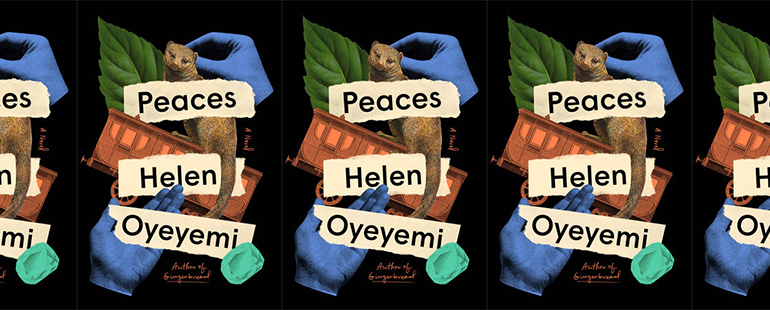The Art of Ambiguity

In Helen Oyeyemi’s new novel, Peaces, out tomorrow, story and backstory blend into a wild wonderland full of rabbit holes that seem to lead nowhere and yet somehow connect. The narrative both centers and decenters its protagonists, who also seem to be minor characters in the abstract mysteries unraveling around them. The characters’ pasts crowd in on the present, with peculiar ambiguities and coincidences cropping up at every turn. The ongoing journey of the train on which most of the action takes place provides a standard starter-image for the way time appears to pass—as a linear experience, one moment after the next. But the consistency of time and the permanence of physical reality are Oyeyemi’s first targets. Time’s tricky manifestations in the material world point toward ambiguity itself as a poetics of unknowing and unseeing, where no perception can be quite precise or trustworthy.
The speaker for most of the novel is Otto Shin, a “mesmerist” who has just taken the last name of his long-term partner, Xavier. An aunt gifts them a train ride on The Lucky Day for their “non-honeymoon honeymoon,” a celebration of the name change. Otto’s profession casts the story into suspicious territory from the beginning. Is he hypnotizing the reader through the text itself? His method of hypnotism has something to do with altering a person’s perception of time; when describing his failed attempt to hypnotize Xavier’s aunt, he recounts, “I’d have trimmed the edge off Do Yeon-ssi’s sense of time so that she circled and circled the same instant, unable to conceive of any other until the next was presented to her.” In this method, the one being hypnotized is suspended in a state of absorption almost akin to the experience of focused reading, where the perceived passage of time is dictated by the text—the “mesmerist”—while the clocks of the exterior world lie ignored.
The position of the text in relationship with the reader is ambiguous in other ways too. Oyeyemi opens an early chapter with “You should know . . .” but it’s not clear whether Otto is meant to be addressing a hypothetical listening character or if he is simply speaking to the reader in a breaking-the-fourth-wall address. Around the book’s halfway point, Otto (or perhaps Oyeyemi herself) again addresses the reader directly: “I never have anything up my sleeve except for the utterly fraudulent authority with which I assure you—yes, you—that you’ll get through this, whatever it is, and everything will be better. We both know nothing’s all right, but when I tell you it will be, you take it. If you don’t, it’s because you’re holding out for another outcome altogether.” This reads both as an assurance and as if some sort of deal has been struck. When Oyeyemi writes of “this, whatever it is,” is she referring to the mysterious plot itself or the events of the reader’s own life (“you’ll get through this”)? In a way, these possibilities are yoked to each other through the reader’s participation. The narrative voice manipulates the reader’s experience of time by virtue of its existence in text, which maps the abstract past, present, and future onto the page for consumption. The book—any book—could be considered a physical container for two different kinds of time that intersect only through the reader’s consciousness: the time that passes in the story and the time it takes for the reader to read the text, to turn the pages.
In the opening chapter of Peaces, the reader is presented with another ambiguous manifestation of time in the material world: Otto’s boxers are stitched with the names of the days of the week. Here, like the name of The Lucky Day, the unit of the “day” is torn out of time measurement and instead used to name a physical object. The days are stitched in Czech, a language Otto doesn’t speak—or does he? Later in the novel, Xavier reveals that he has heard Otto speaking Czech in his sleep, saying, “Come closer.” The whole novel seems to say the same to the reader: come closer, squint a little harder, and maybe things will become clear.
When they first board the train, Otto and Xavier enter a carriage marked with “a die that had rolled the number two”—invoking eyes and perception and probability all at once—and for reasons unknown, all the furniture is on the ceiling. They linger there for a moment, but something in the atmosphere imposes a condition, or maybe even a threat. Oyeyemi writes, “We weren’t in the correct carriage, but we weren’t disturbing anything. And we, in turn, would not be disturbed . . . as long as we moved on. If you stuck out your tongue it would dance there, right at the tip: the fizz of conditionality.” This condition is not explained; it’s just a feeling with an implied “or else” lurking behind it, somehow in the essence of the carriage. Here, Xavier catches sight of the train’s mysterious permanent resident, Ava Kapoor, holding up a sign that either says HELLO or HELP. Otto and Xavier want to find Ava, but they also have to find the train car designated on their ticket: Clock Carriage. Like the embroidered boxers and the name of The Lucky Day, Clock Carriage invokes the relationship between intangible time and the tangible material world:
There in Clock Carriage, Xavier’s phone aside, the sky was both lamp and blindfold. Cue the woo-woo perceptions: Maybe this is what it would be like to live inside a clock, or even to be a clock, I thought. Time would tell itself to you, bringing with it a whole host of physical memoranda, the flaring and dwindling of this orb and that. Time would crowd in so close that you didn’t feel it passing. ‘Clocks don’t actually know the time,’ I said to [my mongoose companion] Árpád. ‘They only repeat what they’ve been told.’”
The idea that “time would crowd in so close that you didn’t feel it passing” echoes the description of Otto’s hypnotism technique. Here, the relationship between time and the material world is once again ambiguous—“the flaring and dwindling of this orb and that”—and even clocks can’t be trusted, “only repeat[ing] what they’ve been told.” The question of the moment Otto himself is circling soon surfaces: he once ran into a burning building after seeing a face in the window, a face he finds once again on the train in a self-portrait painted by a man named Přemsyl Stojaspal. Could it be just a coincidence?
Through this incident and others, Přemsyl Stojaspal emerges at the center of an ontological mystery. Sometimes Přemsyl is seen by one person when he isn’t there, and sometimes everyone can see him except for Ava Kapoor, who happens to be about to inherit Přemsyl’s father’s fortune. Does Přemsyl really exist? Is he on the train, or is he only present in memories and paintings? He might be on a mission to prove that he exists, or to prove that Ava is insane, or some other hidden agenda involving the question of whether reality itself is truly consistent across different people’s experiences. Two of his paintings appear to be completely blank, but when pressed to say what’s “in” them, everyone sees the same image. A phenomenon—perhaps a form of magic—of seeing and “unseeing” repeatedly arises. Ava has somehow “unseen” Přemsyl; meanwhile, she writes to Otto and Xavier, “Here’s to unseeing the world.” In one episode, Otto sees a figure on the train whose features won’t come into focus: “I knew I was looking at someone, but I couldn’t make out any features, no matter how I squinted. Nonsense, they’re only a few steps away, of course you can see what they look like.” Is this figure Přemsyl too? Did the features somehow travel back in time through Otto’s consciousness to the window of that burning building, where there turned out to be no one there? How does this phenomenon of seeing and “unseeing” operate? The answers, like the characters’ memories, are left intentionally half-obscured; like the sky seen from Clock Carriage, the storytelling serves as “both lamp and blindfold.”
The only definite truth in the novel seems to be Xavier and Otto’s love for each other; they are “X and O,” kisses and hugs, unambiguously in love even when each cannot fully know the other’s inner world. They catch moments of peace in each other’s arms throughout the novel, repeatedly finding security in their choice to share a last name. It’s not a love story, but it’s a story shot through with love. Meanwhile, the outer world they inhabit is unstable and full of questions; has someone else been pulling the strings in their world all along? In this question, the figure of Přemsyl may also be a metanarrative device pointing toward the unknowable intent of the author herself and the fact that nothing is really a coincidence in the world of fiction. Somebody from the world beyond really is pulling the strings in Otto and Xavier’s story, and that somebody has a wild sense of humor.


